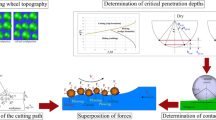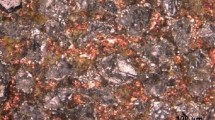Abstract
In this work, we focus on the computational bridging between the meso- and macro-scale in the context of the hybrid modelling of Internal Traverse Grinding with electro-plated cBN wheels. This grinding process satisfies the manufacturing industry demands for a high rate of material removal along with a high surface quality while minimising the number of manufacturing processes invoked. To overcome the major problem of the present machining process, namely a highly concentrated thermal load which can result in micro-structural damage and dimension errors of the workpiece, a hybrid simulation framework is currently under development. The latter consists of three components. First, a kinematic simulation that models the grinding wheel surface based on experimentally determined measurements is used to calculate the transient penetration history of every grain intersecting with the workpiece. Secondly, an h-adaptive, plane-strain finite element model incorporating elasto-plastic work hardening, thermal softening and ductile damage is used to simulate the proximity of one cBN grain during grinding and to capture the complex thermo-mechanical material response on a meso-scale. For the third component of the framework, the results from the preceding two simulation steps are combined into a macro-scale process model that shall in the future be used to improve manufacturing accuracy and to develop error compensation strategies accordingly. To achieve this objective, a regression analysis scheme is incorporated to approximate the influence of the several cutting mechanisms on the meso-scale and to transfer the homogenisation-based thermo-mechanical results to the macro-scale.













Similar content being viewed by others
References
Ahearne E, Byrne G (2008) Simulation of the local kinematics in rotational grinding. CIRP Ann Manuf Technol 57(1):333–336. doi:10.1016/j.cirp.2008.03.080
Altintas Y, Kersting P, Biermann D, Budak E, Lazoglu BDI (2014) Virtual process systems for part machining operations. CIRP Ann Manuf Technol 63(2):585–605. doi:10.1016/j.cirp.2014.05.007
Aurenhammer F (1991) Voronoi diagrams—a survey of a fundamental geometric data structure. ACM Comput Surv 23(3):345–405. doi:10.1145/116873.116880
Aurenhammer F, Klein R, Lee DT, Klein R (2013) Voronoi diagrams and delaunay triangulations. World Scientific, Singapore
Aurich J, Kirsch B (2012) Kinematic simulation of high-performance grinding for analysis of chip parameters of single grains. CIRP J Manuf Sci Technol 5(3):164–174. doi:10.1016/j.cirpj.2012.07.004
Brinksmeier E, Aurich J, Govekar E, Heinzel C, Hoffmeister HW, Klocke F, Peters J, Rentsch R, Stephenson D, Uhlmann E, Weinert K, Wittmann M (2006) Advances in modeling and simulation of grinding processes. CIRP Ann Manuf Technol 55(2):667–696. doi:10.1016/j.cirp.2006.10.003
Chakrabarti S, Paul S (2008) Numerical modelling of surface topography in superabrasive grinding. Int J Adv Manuf Technol 39(1–2):29–38. doi:10.1007/s00170-007-1201-y
Foley JD, Feiner S, Hughes JF, Phillips RL (1994) Introduction to computer graphics. Addison-Wesley Longman Publishing Co, Boston
Herzenstiel P, Aurich JC (2010) cBN-grinding wheel with a defined grain pattern—extensice numerical and experimental studies. Mach Sci Technol 14(3):301–322. doi:10.1080/10910344.2010.511574
Holtermann R, Schumann D, Menzel A, Biermann D (2014) A hybrid approach to the modelling and simulation of grinding processes. In: Proceedings of 11th World Congress Computational Mechanics (WCCM XI), Ebook, pp 1932–1937
Holtermann R, Schumann S, Menzel A, Biermann D (2013) Modelling, simulation and experimental investigation of chip formation in internal traverse grinding. Prod Eng Res Dev 7(2–3):251–263. doi:10.1007/s11740-013-0449-3
Hortig C (2011) Local and non-local thermomechanical modeling and finite-element simulation of high-speed cutting. Ph.D. thesis, TU Dortmund, Institute of Mechanics
Carslaw HS, Jaeger JC (1959) Conduction of Heat in Solids. Oxford University Press, London
Jackson MJ, Davim JP (2011) Machining with abrasives. Springer-Verlag, Berlin Heidelberg
Johnson G, Cook W (1983) A constitutive model and data for metals subjected to large strains, high strain rates and high temperatures. In: Proceedings of the 7th International Symposium on Ballistics, vol 1, pp 541–547
Joliet R, Kansteiner M (2013) A high resolution surface model for the simulation of honing processes. Adv Mater Res 769:69–76. doi:10.4028/www.scientific.net/AMR.769.69
Koshy P, Iwasald A, Elbestawl M (2003) Surface generation with engineered diamond grinding wheels: insights from simulation. CIRP Ann Manuf Technol 52(1):271–274. doi:10.1016/S0007-8506(07)60582-4
Kumar S, Paul S (2012) Numerical modelling of ground surface topography: effect of traverse and helical superabrasive grinding with touch dressing. Prod Eng Res Dev 6(2):199–204. doi:10.1007/s11740-012-0370-1
Liu Y, Warkentin A, Bauer R, Gong Y (2013) Investigation of different grain shapes and dressing to predict surface roughness in grinding using kinematic simulations. Precis Eng 37(3):758–764. doi:10.1016/j.precisioneng.2013.02.009
Marschalkowski K (2010) Beitrag zur Prozessentwicklung für das Hochleistungsinnenrund-Schälschleifen mit galvanisch gebundenen cBN-Schleifscheiben. Ph.D. thesis, TU Dortmund University
Marschalkowski K, Biermann D, Weinert K (2010) On the characteristics of high-performance internal traverse grinding using electroplated cbn wheels. In: Aoyama T, Takeuchi Y (eds) Proceedings of the 4th CIRP International Conference on High Performance Cutting (CIRP HPC 2010), vol. 1, pp 393–398
de Payrebrune K (2013) Analyse und Modellierung der Prozess-Strukturwechselwirkungen beim Werkzeugschleifen. Dissertation, Institut für Maschinenelemente, Konstruktion und Fertigung, TU Bergakademie Freiberg University
Poulachon G, Moisan A (2001) Performance evaluation on hardened steel-(pcbn) tool pair in high speed turning. In: Schulz H (ed) Scientific fundamentals of HSC. Carl Hanser Verlag, Munich, pp 161–171
Rausch S, Odendahl S, Kersting P, Biermann D, Zabel A (2012) Simulation-based prediction of process forces for grinding free-formed surfaces on machining centers. Proc CIRP 4:161–165. doi:10.1016/j.procir.2012.10.029
Rausch S, Siebrecht T, Kersting P, Biermann D (2014) Analysis and simulation of surface topographies in grinding of thermally sprayed coatings. Adv Mater Res 1018:91–98. doi:10.4028/www.scientific.net/AMR.1018.91
Salisbury E, Domala K, Moon K, Miller M, Sutherland J (2001) A three-dimensional model for the surface texture in surface grinding, Part 1: surface generation model. J Manuf Sci Eng Trans ASME 123(4):576–581. doi:10.1115/1.1391427
Salisbury E, Domala K, Moon K, Miller M, Sutherland J (2001) A three-dimensional model for the surface texture in surface grinding, Part 2: grinding wheel surface texture model. J Manuf Sci Eng Trans ASME 123(4):582–590. doi:10.1115/1.1391428
Schumann S, Holtermann R, Biermann D, Menzel A (2013) Hochleistungs-Innenrundschälschleifen: Thermomechanische Betrachtung in Abhängigkeit vom radialen Gesamtaufmaß. Diam Bus 11(2):36–43
Acknowledgments
Financial support by the Deutsche Forschungsgemeinschaft (DFG) in the context of SPP 1480 (Project IDs: ME 1745/7-3; BI 498/23-3) is gratefully acknowledged.
Conflict of interest
The authors declare that they have no conflict of interest.
Author information
Authors and Affiliations
Corresponding author
Rights and permissions
About this article
Cite this article
Holtermann, R., Menzel, A., Schumann, S. et al. Modelling and simulation of Internal Traverse Grinding: bridging meso- and macro-scale simulations. Prod. Eng. Res. Devel. 9, 451–463 (2015). https://doi.org/10.1007/s11740-015-0613-z
Received:
Accepted:
Published:
Issue Date:
DOI: https://doi.org/10.1007/s11740-015-0613-z




